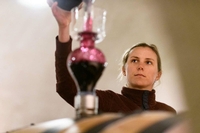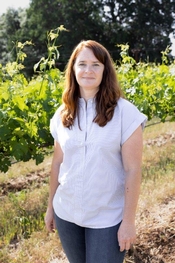Maura Kinsella, Associate Winemaker, Hamel Family Wines:

Maura Kinsella (MK): "I’m originally from the Midwest and moved out West to study Biology at Santa Clara University. During college and for three years full-time afterward, I raced road bikes professionally and for the US National team. For a European-centric racing calendar, I split my time between Boulder, CO, the Netherlands, and Spain. After a successful spring campaign in 2014, I had a crash-marred 2015 season. The risks outweighed the rewards, so I naturally transitioned from professional cycling to winemaking. Ironically, while traveling throughout Europe for bike racing, I developed a passion for wine, becoming a student of its history and culture and trying to learn as much as I could about how wine is made.”
“Serendipitously, a partner of one of my teammates was a winemaker in Napa, so I started talking to him about winemaking as a career. He gave me great advice: before I studied winemaking in a formal class setting, I needed to go and do a harvest to make sure I liked all the dirty, sticky, physical work that is the practical side of winemaking. I went to New Zealand to work at a small winery in North Canterbury shortly after. There, I befriended young people in the industry who introduced me to biodynamic and low-intervention winemaking, sparking that persisting passion. I then applied to different Master’s programs, and that fall, I attended the University of Bordeaux to study winemaking and viticulture. During my time in France, I was fortunate to work extended internships in the vineyard and winery at Chateau Palmer in Margaux and then in St.-Émilion and Pomerol with Christian Moueix’s group of Chateaux. After Bordeaux, I went to Chile to work at Emiliana Organic Vineyards and then to Eisele Vineyard in Napa in 2019, marking an end to my ex-pat days. In early March 2020, I finally put my roots down in Sonoma and started working at Hamel, where I’ve been ever since."
MF: Are there any unique qualities or perspectives that, as a woman, you bring to winemaking that you believe enhance the art of winemaking? What goals in winemaking are you still working to achieve?
ML: “As a woman in winemaking, it’s more about bringing another perspective to the industry. Women often have unique organizational skills, attention to detail, ability to multitask, adaptability when working in dynamic situations, discerning palates, and a willingness to teach and mentor up-and-coming winemakers that make for a great set of skills to bring to the industry. I have been fortunate enough to have learned from many inspirational women winemakers: Sabrina Pernet (Palmer), Noelia Orts (Emiliana), and Helene Mingot (Eisele). My goal in winemaking is to constantly push myself and motivate our team in our quest to make “the perfect wine.” It’s like trying to reach the “limit” in math, a never-ending journey.”
MF: What changes and trends, if any, do you hope to see in the future of the wine industry?
ML: “I want to see more producers working towards lower intervention winemaking, sustainable farming practices, utilizing less new oak in aging, and producing lower alcohol wines. I’m eager to see the marketplace complete of wines that are stripped of the “techniques” learned in school but instead distilled down to the purity of vineyard sites’ character.”
MF: How do you engage with the local community or contribute to the wine industry’s development in Sonoma?
ML: “I have participated in local Sonoma restaurants’ “Winery of the Month” evenings and hosted industry technical tastings for local winemaking teams. Community is so important in the wine industry because it’s how we can help positively effect change and engage with our neighbors.”
MF: Can you recommend some of your favorite wines that you’ve either made or admired from other female winemakers?
ML: "Along with the rest of our winegrowing team, a wine that I’m particularly fond of that we’ve made is Hamel’s 2021 Estate Grenache. It’s an elegant, energetic, and transparent representation of our volcanic mountain terroir at Nuns Canyon Vineyard. Other wines I enjoy from female winemakers abroad are Champalou in Vouvray, Ariana Occhipinti’s wines in Sicily, Laura Zapata’s wines in Argentina, and Sabrina Pernet’s contribution to Chateau Palmer. Domestically, there are so many, and I have deep respect and gratitude for the pioneers in the industry like Cathy Corison, but top of mind is Jasmine Hirsch at Hirsch Vineyards."
Joy Merrilees, Vice President of Production, Shannon Family of Wines:

MF: Can you share a bit about your winemaking journey? What sparked your interest in this field, and how did you get started?
Joy Merrilees (JM): “I went to school for plant science and art design. Originally, I thought landscape design was the best combination of the two, however, I realized wine was a much better option to create something amazing with plants, well, vines, in this case. I went on exchange to Lincoln University in NZ for landscape classes. I fell head-over-heels for winemaking and creating wine from a specific terroir that I snuck into the enology courses for the rest of the semester. I’ve come full circle now with Shannon Family of Wines producing organic wines grown on volcanic soils that have notes of the pungent, spicy, and fresh native botanicals that grow in between the rows. Plants on plants!”
MF: Are there any unique qualities or perspectives that, as a woman, you bring to winemaking that you believe enhance the art of winemaking? What goals in winemaking are you still working to achieve?
JM: “From our ancient societal roles, I believe women can have an intimate relationship with aromas and flavors. We can play to both the masculine and feminine characters in wine and create a natural balance between the two. I would love to make a timeless wine, something as delicious as the day it was bottled and just as delicious when it’s 50 years old; that’s not easy."
MF: What changes and trends, if any, do you hope to see in the future of the wine industry?
JM: “I hope to see varieties other than Cabernet and Chardonnay become top-selling wines. I hope people will learn there are more flavors of wine in the world than hard seltzers.”
JM: "I’m the Vice Chair of the Lake County Wine Grape Commission. I’m also the first to raise my hand when there is a chance to talk with and educate people about current wine industry events. It’s so dynamic, and most people don’t understand how challenging an industry it is. The romance is strong."
MF: Can you recommend some of your favorite wines that you’ve either made or admired from other female winemakers?
JM: “Our Ovis Nero d’Avola is delicious, medium weight, and screams volcanic terroir and anything by Loveblock, the innovative and organic winemaker Erica Crawford.”
